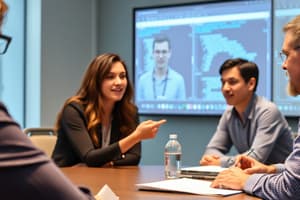Podcast
Questions and Answers
What is the primary focus of personal reflection?
What is the primary focus of personal reflection?
- Evaluation of personal experiences and values (correct)
- Interpreting data collected by others
- Analysis of group experiences
- Observing others in different contexts
How does participant observation differ from non-participant observation?
How does participant observation differ from non-participant observation?
- Participant observation only focuses on group activities.
- Participant observation is only applied in interviews.
- Non-participant observation requires the researcher to actively engage.
- Participant observation allows for direct engagement, while non-participant does not. (correct)
Which technique involves analyzing personal experiences in research?
Which technique involves analyzing personal experiences in research?
- Data triangulation
- Non-participant observation
- Personal reflection (correct)
- Participant observation
What does the term 'non-participant observation' mean?
What does the term 'non-participant observation' mean?
In participant observation, how is the role of the researcher typically characterized?
In participant observation, how is the role of the researcher typically characterized?
What is a likely outcome of personal reflection in research?
What is a likely outcome of personal reflection in research?
Which of the following best describes the purpose of participant observation?
Which of the following best describes the purpose of participant observation?
What does the analysis in personal reflection primarily demonstrate?
What does the analysis in personal reflection primarily demonstrate?
What is the primary nature of interviews that use open-ended questions?
What is the primary nature of interviews that use open-ended questions?
What is the main objective of conducting a focus group?
What is the main objective of conducting a focus group?
What does secondary research primarily involve?
What does secondary research primarily involve?
What is a critical aspect of observation in research?
What is a critical aspect of observation in research?
What role does the researcher play in secondary research?
What role does the researcher play in secondary research?
What is typically derived from the findings of qualitative research?
What is typically derived from the findings of qualitative research?
What is a potential use of statistical analysis in research?
What is a potential use of statistical analysis in research?
Which of the following is a characteristic of qualitative research methods?
Which of the following is a characteristic of qualitative research methods?
What characterizes micro-level relationships among team members?
What characterizes micro-level relationships among team members?
Which of the following groups operates at the meso level?
Which of the following groups operates at the meso level?
What is a distinguishing feature of the meso level?
What is a distinguishing feature of the meso level?
How do meso-level groups interact with macro-level institutions?
How do meso-level groups interact with macro-level institutions?
What primarily defines macro-level interactions?
What primarily defines macro-level interactions?
What is an example of a meso-level organization mentioned in the content?
What is an example of a meso-level organization mentioned in the content?
What is a primary characteristic of macro-level organizations?
What is a primary characteristic of macro-level organizations?
In what way do macro-level institutions influence micro and meso levels?
In what way do macro-level institutions influence micro and meso levels?
What does the nature vs nurture debate primarily address?
What does the nature vs nurture debate primarily address?
How is adolescence perceived differently in various cultures?
How is adolescence perceived differently in various cultures?
How is touch significant in interpersonal relationships?
How is touch significant in interpersonal relationships?
What is one of the impacts of modern society on the concept of adolescence?
What is one of the impacts of modern society on the concept of adolescence?
What does proxemics refer to in non-verbal communication?
What does proxemics refer to in non-verbal communication?
According to Karl Mannheim's Theory of Generations, what is a key factor shaping an individual's identity?
According to Karl Mannheim's Theory of Generations, what is a key factor shaping an individual's identity?
Which statement best reflects the role of family in shaping identity?
Which statement best reflects the role of family in shaping identity?
Which of the following statements about self-disclosure is accurate?
Which of the following statements about self-disclosure is accurate?
According to Tannen's studies, which gender difference in communication was found?
According to Tannen's studies, which gender difference in communication was found?
What is a viewpoint regarding sexuality's influence on identity?
What is a viewpoint regarding sexuality's influence on identity?
What impact did rising transport costs have on public access?
What impact did rising transport costs have on public access?
Which of the following is a characteristic of the adolescent stage in Western societies?
Which of the following is a characteristic of the adolescent stage in Western societies?
How do the Maasai view the transition from childhood to adulthood?
How do the Maasai view the transition from childhood to adulthood?
What does attribution theory explain about human behavior?
What does attribution theory explain about human behavior?
What was a key consequence of Castro's guerrilla war in Cuba?
What was a key consequence of Castro's guerrilla war in Cuba?
How did women tend to self-disclose in their relationships, according to Reis?
How did women tend to self-disclose in their relationships, according to Reis?
Flashcards are hidden until you start studying
Study Notes
Research Methods and Data Collection
- Open-ended interviews are qualitative, allowing for in-depth exploration of participant views and experiences.
- Focus groups involve moderated discussions with small groups to collect rich qualitative data on a defined topic.
- Secondary research utilizes existing data produced by other researchers for synthesis and analysis.
- Personal reflection combines personal experience with critical evaluation to interpret data within the research context.
- Participant observation requires researchers to embed within a group while maintaining covert roles, while non-participant observation involves watching interactions without direct engagement.
Levels of Interaction in Society
- Micro-level interactions are personal and interpersonal, fostering strong relationships among team members.
- Meso-level encompasses structured groups like schools and local clubs, providing an interface between individuals and larger organizations.
- Macro-level consists of large institutions and systems, typically bureaucratic and impacting society at national/global levels; examples include Cricket Australia and ICC.
Identity Influences
- Family and kinship significantly shape identity through embedded values and traditions.
- Ethnicity and culture influence identity formation, providing contextual frameworks for self-perception.
- Gender roles contribute to identity development, often dictating behavioral expectations and societal positioning.
- Sexuality impacts identity, informing personal and social relationships and self-acceptance.
- Media representation plays a critical role in shaping societal norms and individual identity perceptions.
Nature vs. Nurture Debate
- Nature pertains to genetic and biological traits, while nurture refers to social and environmental influences.
- The debate centers on the extent to which biology or environment shapes human behavior and identity.
Adolescence as a Social Construct
- Adolescence is a societal phase between childhood and adulthood, increasingly associated with prolonged education and delayed adulthood.
- Cultural definitions of adolescence vary; for instance, Amish encourage early work experiences while Arab youths are expected to prioritize family commitments.
- In contrast, in Maasai culture, males transition directly from childhood to adulthood without a distinct adolescence phase.
Karl Mannheim's Theory of Generations
- Individuals born in similar historical contexts share common values and identity shaping influenced by cultural and social factors.
Non-verbal Communication and Proxemics
- Proxemics, as defined by Edward T Hall, studies how personal space communicates social cues, with varied interpretations across cultures.
- Cultural misunderstandings may arise in negotiations due to differing spatial customs, e.g., Arab and English negotiation styles.
Communication in Social Relationships
- Attribution theory explains how individuals deduce behaviors based on observations, impacting interactions and perceptions.
- Social penetration theory highlights that self-disclosure in relationships promotes intimacy, with findings suggesting women tend to disclose more than men.
- Gender differences in conversation styles are noted, such as men interrupting more frequently and women seeking emotional support.
Historical Case Study
- The 26th of July Movement, led by Fidel Castro and Che Guevara, initiated guerrilla warfare in Cuba, leading to Castro's rise and establishment of a Marxist-Leninist government in 1959.
Social Control through Transportation
- Increased transport costs and reduced accessibility resulted in limited travel, enhancing governmental surveillance capabilities over local populations.
Studying That Suits You
Use AI to generate personalized quizzes and flashcards to suit your learning preferences.




